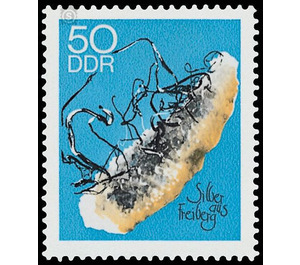Minerals from the collections of the Freiberg Mining Academy - Germany / German Democratic Republic 1969 - 50 Pfennig
Theme: Geology & Geography
| Country | Germany / German Democratic Republic |
| Issue Date | 1969 |
| Face Value | 50.00 |
| Color | blue |
| Perforation | K 14 |
| Printing Type | Photogravure |
| Stamp Type | Postage stamp |
| Item Type | Stamp |
| Chronological Issue Number | 1215 |
| Chronological Chapter | GER-DDR |
| SID | 654858 |
| In 11 Wishlists | |
Beautiful minerals of the GDR The Ministry of Posts and Telecommunications of the GDR publishes a series with six multicolored special postage stamps on which beautiful minerals from the German Democratic Republic are depicted. Minerals of the GDR Many types and varieties of minerals have been described in the scientific literature for the first time in the Ore Mountains, the Thuringian Forest and the Harz. A large number of minerals occur in the territory of the German Democratic Republic in excellent quality and special beauty. For these reasons, minerals of our homeland can be found in all the major collections in the world. As in recent years again and again interesting findings of minerals were discovered in the GDR, the issue of a stamp series with mineral motifs is of particular relevance. The minerals displayed on the stamps were all found on the territory of the GDR today. The steps are stored in the mineralogical collection of the Geosciences section of the Bergakademie Freiberg. 50 Pfennig value: Silver Ag Pit Himmelsfürst, Brand near Freiberg (Saxony) (No. 730) Silver is one of the precious metals that are dwarfed in nature, d. H. without entering into a connection with another element occur. The color of the mineral is silver-white, but usually yellowish, brown, gray or black tarnished. Multi-faceted are the forms in which the silver occurs. It usually forms lumps, but also sheets, wires or hair-like strands. According to its metal properties it is flexible and elastic. The step shown on the stamp consists of an approximately 120 x 40 mm calcite plate, on which silver wires are grown up to a height of 50 mm. In the second half of the 19th century, the site, the Himmelfürst mine, was one of the mines in Germany with the richest silver yield. The illustrated minerals give a little insight into the richness and beauty of the mineral deposits of the GDR. The exhibitions of the mineralogical collections at the Bergakademie in Freiberg (Saxony) and the Humboldt University in Berlin provide a much broader overview of this area of nature.


